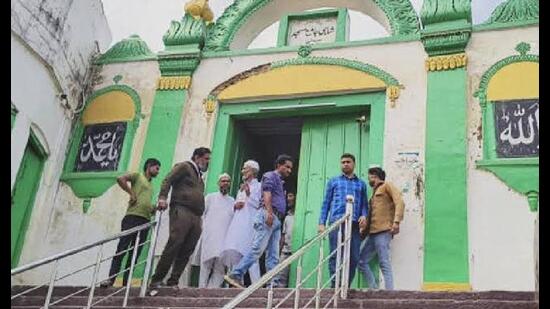ASI begins whitewashing at Sambhal’s Shahi Jama Masjid
Mosque committee president Zafar Ali said, “The whitewashing of the outer wall of the Shahi Jama Masjid began on Sunday morning. ASI team is supervising the work. We are also being consulted by them. Today, 10 workers are working, we have asked ASI to increase the number so that the work can be completed at the earliest.”
The Archaeological Survey of India (ASI) on Sunday began the painting work at the Shahi Jama Masjid in Sambhal district following a directive from the Allahabad high court. The process commenced on Sunday morning with workers applying fresh coats of paint to the mosque’s walls under the supervision of ASI officials and the mosque committee.

Mosque committee president Zafar Ali said, “The whitewashing of the outer wall of the Shahi Jama Masjid began on Sunday morning. ASI team is supervising the work. We are also being consulted by them. Today, 10 workers are working, we have asked ASI to increase the number so that the work can be completed at the earliest.”
“If the work has to be completed in four days, then around 20 labourers would be needed,” he said.
When asked what colours will be put on the outer wall of the mosque, Ali said, “We are using the colours which have been used for hundreds of years. We are using white, green and light golden colours.”
District magistrate Rajendra Pensiya said, “At the direction of the high court, the ASI is doing its work. We have assured ASI that our presence is everywhere in the city in case they need any help. Adequate security arrangements have been made at the site.”
The painting process had initially faced delays. On Saturday, an ASI team arrived at the site with painters, but after a brief stay, they left without starting the work. Consequently, the work could not begin as planned. The ASI later informed the Jama Masjid committee that the painting work would officially start on Sunday morning, ensuring compliance with the court’s instructions.
On March 12, the high court issued an order for the painting and decoration of Jama Masjid, specifying that the ASI would oversee the process. Acting on this directive, an ASI team visited the mosque on March 13, conducting a thorough inspection of both the exterior and interior areas. The team identified sections requiring painting and instructed workers to proceed with the restoration of the mosque’s outer walls.
On Saturday, a three-member ASI team, accompanied by three painters, arrived at Jama Masjid. While some cleaning work was carried out, additional local labourers and painters were also arranged to assist in the process.
The painting work also led to the removal of posters that had sparked a controversy. Several posters had been affixed to the back wall of the mosque, which created tensions in the area. The ASI team removed these posters on Saturday as part of the cleanup process before painting. A total of 74 posters, allegedly featuring images of troublemakers, had been pasted on the mosque’s walls. This act had drawn opposition from the Jama Masjid committee, particularly its president, who protested against the placement of these posters.
Meanwhile, decorative string lights and bulbs for lighting at Sambhal Jama Masjid have been sent from Delhi in a tempo. These lights will be installed in the Jama Masjid after painting and renovation work is completed. The mosque committee had also filed a petition in the High Court for lighting arrangements, an ASI official informed.
Sambhal had been tense after violence broke out on November 24 last year following the second round of a survey of the Shahi Jama Masjid, a Mughal-era mosque here. Four people were killed and several, including police personnel, were injured in the clashes.






